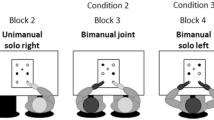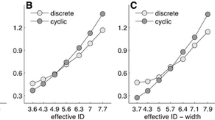Summary
Reaction time for choice between left-hand and right-hand responses sometimes depends on whether the responses assigned to the two hands are the same or different, but sometimes it does not. It has been suggested that the result obtained indicates whether the variable on which the responses differ is determined by common or specific parameters of control. Common parameters apply to movements of both hands, but specific parameters can be set independently for left-hand and right-hand responses. The interpretation of choice RT in terms of intermanual interactions requires that the conclusions converge with conclusions that are based on studies of simultaneous movements, provided that interactions can indeed be attributed to common parameters. Results from the latter type of experiment suggest that duration of aimed movements is determined by common parameters, but amplitude is determined by specific parameters. In two experiments it is shown that the choice-task results are consistent with this conclusion: Choice RT increases when the choice is between aimed movements that differ in duration, but not if the choice is between movements of different amplitudes. Further, an assimilation of responses is found in the former case but not in the latter. These findings are taken as further support for the notion of intermanual interactions during motor programming.
Similar content being viewed by others
References
Annett, M., & Annett, J. (1979). Individual differences in right and left reaction time. British Journal of Psychology, 70, 393–404.
Corcos, D.A. (1984). Two-handed movement control. Research Quarterly for Exercise and Sport, 55, 117–122.
Gunkel, M. (1962). Über relative Koordination bei willkürlichen menschlichen Gliederbewegungen. Pflügers Archiv für die gesamte Physiologie, 275, 472–477.
Heuer, H. (1981). Fast aiming movements with the left and right hand: Evidence for two-process theories of motor control. Psychological Research, 43, 81–96.
Heuer, H. (1982a). Binary choice reaction time as a criterion of motor equivalence. Acta Psychologica, 50, 35–47.
Heuer, H. (1982b). Binary choice reaction time as a criterion of motor equivalence: Further evidence. Acta Psychologica, 50, 49–60.
Heuer, H. (1982c). Choice between finger movements of different and identical form: The effect of relative signal frequency. Psychological Research, 44, 323–342.
Heuer, H. (1983). Reaktionszeit und Genauigkeit bei der Wahl zwischen formgleichen und formverschiedenen Bewegungen beider Hände. Psychologische Beiträge, 25, 532–556.
Heuer, H. (1984a). Bewegungen mit der rechten und linken Hand: Interferenzen bei der Programmierung. Psychologische Beiträge. 26, 561–581
Heuer, H. (1984b). Binary choice reaction time as a function of the relationship between durations and forms of responses. Journal of Motor Behavior, 16, 392–404.
Heuer, H. (1984c). On re-scaleability of force and time in aiming movements. Psychological Research, 46, 73–86.
Heuer, H. (1985). Intermanual interactions during simultaneous execution and programming of finger movements. Journal of Motor Behavior. 17, 335–354
Heuer, H. (in press). Intermanual interactions during programming of finger movements: Transient effects of “homologous coupling”. In H. Heuer & C. Fromm (Eds.) Generation and Modulation of Action Patterns. Berlin: Springer.
Keele, S.W. (1968). Movement control in skilled motor performance. Psychological Bulletin, 70, 387–403.
Keele, S.W. (1981). Behavioral analysis of movement. In V.B. Brooks (Ed.) Handbook of Physiology. Section 1: The Nervous System. Vol. II Motor Control. Bethesda, Maryland: American Physiological Society.
Kelso, J.A.S., Putnam, C.A., & Goodman, D. (1983). On the spacetime structure of human interlimb co-ordination. Quarterly Journal of Experimental Psychology, 35A, 347–375.
Kelso, J.A.S., Southard, D.L., & Goodman, D. (1979a). On the nature of human interlimb coordination. Science, 203, 1029–1031.
Kelso, J.A.S., Southard, D.L., & Goodman, D. (1979b). On the coordination of two-handed movements. Journal of Experimental Psychology: Human Perception and Performance, 5, 229–238.
Klapp, S.T. (1977). Reaction time analysis of programmed control. In R. Hutton (Ed.) Exercise and Sport Sciences Reviews, Vol. V. Santa Barbara: Journal Publishing Affiliates.
Klapp, S.T. (1979). Doing two things at once: The role of temporal compatibility. Memory & Cognition, 7, 375–381.
Klapp, S.T., & Greim, D.M. (1979). Programmed control of aimed movements revisited: The role of target visibility and symmetry. Journal of Experimental Psychology: Human Perception and Performance, 5, 509–521.
MacKay, D.G., & Soderberg, G.A. (1971). Homologous intrusions: An analogue of linguistic blends. Perceptual and Motor Skills, 32, 645–646.
Marteniuk, R.G., & MacKenzie, C.L. (1980a). Information processing in movement organization and execution. In R.S. Nickerson (Ed.) Attention and Performance VIII. Hillsdale, N.J.: Erlbaum.
Marteniuk, R.G., & MacKenzie, C.L. (1980b). A preliminary theory of two-hand co-ordinated control. In G.E. Stelmach & J. Requin (Eds.) Tutorials in Motor Behavior. Amsterdam: North-Holland.
Marteniuk, R.G., MacKenzie, C.L., & Baba, D.M. (1984). Bimanual movement control: Information processing and interaction effects. Quarterly Journal of Experimental Psychology, 36A, 335–365.
Meyer, D.E., Smith, J.E.K., & Wright, C.E. (1982). Models for the speed and accuracy of aimed movements. Psychological Review, 89, 449–482.
Oldfield, R.C. (1971). The assessment and analysis of handedness. The Edinburgh Inventory. Neuropsychologia, 9, 97–113.
Peters, M. (1981). Attentional asymmetries during concurrent bimanual performance. Quarterly Journal of Experimental Psychology, 35A, 95–103.
Preilowski, B. (1975). Bilateral motor interaction: Perceptual-motor performance of partial and complete “split-brain” patients. In K.J. Zülch, O. Creutzfeldt, & G.G. Galbraith (Eds.) Cerebral Localization, Berlin: Springer.
Rosenbaum, D.A. (1980). Human movement initiation: Specification of arm, direction, and extent. Journal of Experimental Psychology: General, 109, 444–474.
Rosenbaum, D.A. (1983). The movement precuing technique: Assumptions, applications, extensions. In R.A. Magill (Ed.) Memory and Control of Action. Amsterdam: North-Holland.
Rosenbaum, D.A. (1985). Motor programming. In H. Heuer, U. Kleinbeck, & K.-H. Schmidt (Eds.) Motor Behavior: Programming, Control, and Acquisition. Berlin: Springer.
Rosenbaum, D.A., & Kornblum, S. (1982). A priming method for investigating the selection of motorresponses. Acta Psychologica, 51, 223–243.
Schmidt, R.A. (1980). On the theoretical status of time in motor program representation. In G.E. Stelmach & J. Requin (Eds.) Tutorials in Motor Behavior. Amsterdam: North-Holland.
Schmidt, R.A. (1984). The search for invariance in skilled movement behavior. Report No. 11, Research Group on Perception & Action at ZiF, Bielefeld.
Schmidt, R.A., Zelaznik, H.N., Hawkins, B., Frank, J.S., & Quinn, J.T. (1979). Motor-output variability: A theory for the accuracy of rapid motor acts. Psychological Review, 86, 415–451.
Schmidtke, H. (1960). Über die Struktur willkürlicher Bewegungen. Psychologische Beiträge, 5, 428–439.
Sheridan, M.R. (1979). A reappraisal of Fitts' law. Journal of Motor Behavior, 11, 179–188.
Author information
Authors and Affiliations
Rights and permissions
About this article
Cite this article
Heuer, H. Intermanual interactions during programming of aimed movements: Converging evidence on common and specific parameters of control. Psychol. Res 48, 37–46 (1986). https://doi.org/10.1007/BF00309277
Received:
Issue Date:
DOI: https://doi.org/10.1007/BF00309277




